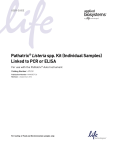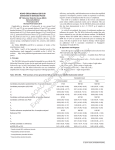Download InstantLabs Listeria species Food Safety Kit
Transcript
LABORATORY USE ONLY InstantLabs® Listeria species Food Safety Kit P/N 9034-0600-0015 PRODUCT DESCRIPTION The InstantLabs Medical Diagnostics Corporation (InstantLabs) Listeria species Food Safety Kit contains the reagents necessary for performing qualitative, real-time PCR on the Hunter Accelerated PCR® system (see Hunter System Specifications below). The kit is intended to be used in an analytical laboratory under standard laboratory conditions. KIT STORAGE AND STABILITY Store the InstantLabs® Food Safety Kit at 2 - 8° C. The reagents are stable through the expiration date printed on the kit. MATERIALS REQUIRED AND PROVIDED • • Multiple Assay Cartridges (MAC) Reagent Packs each containing the following: o 5 – Colored Tubes With Lyophilized PCR Reagents o 4 – Sample Extraction Tubes o 1 – Tube of PCR Positive Control o 1 – Tube of Nuclease-Free Water ADDITIONAL MATERIALS REQUIRED BUT NOT PROVIDED: 1. Hunter Accelerated PCR® Instrument 2. Nitrile or Latex Gloves 3. Buffered Listeria Enrichment Broth (InstantLabs or Other Supplier) 4. 10-100 µL Pipette with RNase/DNase-Free Filter Tips 5. Heat Block Set at 95o C 6. Incubator Set at 35o C 7. Micro-Centrifuge Capable of at Least 6,000 x g 8. Vortex w/1.5 mL Tube Adaptor For Food Samples Only: 9. Whirl-Pak® Filter Bag for Homogenizer Blenders or Other Similar Filter Bag 10. Sterile Transfer Pipet of Suitable Capacity Or Similar Sterile Liquid Measuring Device (Liquid Food Samples Only) 11. Sterile Spatula (Solid Food Samples Only) 12. Laboratory Balance with a Sensitivity of at Least 1 g (Solid Food Samples Only) 13. Stomacher® Instrument Or Similar Homogenizer Blender (Optional for most food types but recommended for meat and other samples that cannot be effectively mixed by hand) For Environmental Surface Samples Only: 14. Sterile Swabs Pre-Moistened with Neutralizing Buffer (Sealed Concrete Surfaces Only) 15. Sterile Sponges Pre-Moistened with Neutralizing Buffer (Ceramic and Stainless Steel Surfaces Only) 16. Sterile 15 ml capped tubes (Swabs Only) 17. Whirl-Pak® Bags, Non-Filtered (Sponges Only) WARNINGS AND PRECAUTIONS 1. Wear eye protection, gloves, and laboratory coats when handling samples and kit reagents. 2. Avoid contamination of reagents by only using sterile pipette tips. 3. Do not use kits beyond the printed expiration date. 4. Do not use kits that have been stored above 8°C. 5. A negative and a positive control must be included in each test. 6. Do not reuse excess reagents from one reagent pack to another, dispose of all remaining reagents once all kit MACs have been used. 7. Material Safety Data Sheets (MSDS) are available upon request. 8. Treat enriched samples as if they contain pathogenic bacteria. 9. Enriched samples and MACs should be disposed of as biohazardous waste according to local regulations. AVOIDING CROSS-CONTAMINATION The InstantLabs® Listeria species Food Verification Kit targets a specific region of bacterial genomic DNA which can be present in high copy number in contaminated foods. To minimize the potential for cross-contamination of samples and false positive results please review these recommendations: A. Always wipe the bench area with a freshly prepared 10% bleach solution and wipe until dry before and after running the assay. B. Regularly clean and decontaminate pipets, tube racks, centrifuge, and laboratory balances by following the manufactures instructions. C. Always use a new filtered pipet tip when pipetting reagents or samples. D. Wear clean disposable gloves at all times and change gloves regularly especially between the Sample Preparation, DNA Extraction, and PCR Setup steps. E. Physically separate the steps of Sample Collection, DNA Extraction, and PCR Setup into different areas of the laboratory if possible. F. Use a different set of pipets and racks for the Sample Preparation, DNA Extraction, and PCR Setup if available. G. Use care when opening tubes in order to avoid splashing or spilling of reagents or samples. H. Clean up spills immediately and wash contaminated area with 10% bleach solution and wipe until dry. I. After PCR amplification is complete, dispose of the used MAC cartridge appropriately. Do not open caps on used MAC cartridge or attempt to reuse. INSTRUCTIONS FOR USE FOR TESTING OF FOOD SAMPLES (25 g) Sample Collection, Homogenization, and Enrichment 1. Prepare 225 mL of Buffered Listeria Enrichment Broth (BLEB) for each sample to be tested by following the manufacturer’s instructions. Ensure that the temperature of the broth is at approximately room temperature immediately before use. 2. Clean the work area and weighing scale with a 10% bleach solution and wipe until dry. 3. Using clean disposable gloves, carefully open and place a new Whirl-Pak bag onto the laboratory scale. 4. Aseptically transfer approximately 25 g of a representative food sample to the bag using a sterile spatula or scoop. For liquid samples, transfer 25 mL using a sterile pipet. It is important to try to work quickly to minimize the chances of contaminating the sample. 5. Repeat steps 3 and 4 (above) for each additional sample to be tested. 6. Pour 225 mL of room temperature BLEB into each bag and loosely seal bag with built-in wire closures. If necessary, sample size may deviate from 25 g depending on availability of the sample, as long as the amount of BLEB is adjusted proportionally. 7. Gently hand massage Whirl-Pak bag(s) for 1 – 2 minutes to mix contents. Note that samples containing meats or other difficult to mix materials should instead be homogenized using a Stomacher machine for 30-60 seconds at normal speed. 8. Incubate the Whirl-Pak bag(s) without shaking at 35°C +/1°C for 24 - 28 hours. FOR TESTING ENVIRONMENTAL SURFACE SAMPLES Sample Collection, Homogenization, and Enrichment SURFACE Sealed Concrete Stainless Steel TYPE Swab Sponge AREA 1” x 1” 4” x 4” MEDIA USED 10 ml 100 ml 1. Prepare the designated amount of Buffered Listeria Enrichment Broth (BLEB) for each sample to be tested by following the manufacturer’s instructions (see above table for required volumes). Bring the media to approximately room temperature immediately before use. For swab samples, aliquot 10 ml of BLEB to the appropriate number of sterile 15 ml tubes. 2. Depending on the surface to be tested, wipe the specified area with the pre-moistened swab or sponge (see above table). Wipe the entire area side to side, then repeat the motion at a 90 ̊ angle, making sure to wipe the entirety of the area specified. 3. Prepare sample for enrichment: a. For swabs, break off the top of the swab into the 15 mL tube containing 10 ml of BLEB and cap. Vortex for 15-30 seconds to dislodge bacterial cells. Loosen cap slightly. b. For sponges, place the entire sterile portion of the sponge in the Whirl-Pak ® Bag along with 100 ml of sterile BLEB. Close and vigorously hand massage for 2 minutes. If the entirety of the sponge/sponge handle is not sterilized, break off or sequester the non-sterile portion of the sponge/sponge handle. 4. Repeat steps 2 and 3 (above) for each additional sample to be tested. 5. Incubate the Whirl-Pak bag(s) without shaking at 35°C +/1°C for 22 - 28 hours. DNA Extraction from Enriched Samples 1. Clean the work area and laboratory pipets with a 10% bleach solution and wipe until dry. 2. Firmly tap Sample Extraction tubes on the laboratory bench to collect contents at bottom of tube. Label each tube or complete included tracking card with identifying information for the sample to be tested. 3. Remove Whirl-Pak bag(s) or tube(s) from incubator and gently agitate the contents. Allow large food debris to settle. 4. For Food Samples: Carefully open the bag and remove 25 µL of liquid from the top 1 – 3 cm of the filtered compartment of the WhirlPak bag without disturbing the settled food debris and place into the correctly labeled Sample Extraction tube prepared in step 2 above. Note that if a layer of fat is present, move pipet tip to below the fat layer before removing aliquot. For Environmental Samples: Carefully open the bag or tube and remove 25 µL of liquid and place into the correctly labeled Sample Extraction tube prepared in step 2 above. 5. Repeat step 4 for each sample to be tested. 6. Gently invert Sample Extraction tube(s) 3 – 5 times to ensure sample is mixed with the lysis reagents. 7. Vortex Sample Extraction tubes at maximum speed for 10 minutes. Use a 1.5 mL tube adaptor on the vortex to securely hold tube. 8. Heat Sample Extraction tubes to 95°C +/-1°C for 10 minutes in a dry heat block to complete the lysis. Allow tube(s) cool at room temperature for 1 - 2 minutes. 9. Gently invert Sample Extraction tube(s) 3 – 5 times and then centrifuge tube(s) in a Micro-Centrifuge for 2 minutes at maximum speed to pellet the lysing beads and any food debris. The supernatant contains the extracted DNA and is ready to be tested immediately with the InstantLabs® Food Safety Kit (see next section on PCR Setup). Note that when removing the supernatant be careful to avoid disturbing settled material. For food samples with high fat or oil content, an oil/fat layer can form over the extracted DNA sample in the Sample Extraction tube. Avoid the top layer and collect the sample from below for PCR. Graphic of Sample Extraction Tube Following Centrifugation If sample testing will be delayed beyond 30 minutes, transfer 100 uL of supernatant to a new nuclease-free microcentrifuge tube and freeze at -20° C. The samples may be frozen for up to 3 months prior to testing. Thaw frozen samples on ice and centrifuge at maximum speed for 3 minutes before use. PCR Setup Overview: Each Reagent Pack and Multiple-Assay Cartridge (MAC) can be used to run up to 4 samples plus the required positive and negative controls. The tubes in the reagent pack are color-coded to match the wells on the MAC and contain convenient ready-to-use lyophilized reagents: Procedure: 1. Clean workspace and pipets with a 10% bleach solution and wipe until dry. 2. Using clean gloves remove Lyophilized PCR Reagents Pack from the kit. 3. Make sure the lyophilized reagents are collected in the bottom of each tube by tapping tubes on benchtop. 4. Using a sterile pipet transfer 25 uL of Nuclease-Free Water to the blue colored Negative Control tube. Tap tube gently on benchtop to ensure that lyophilized reagents are reconstituted. 5. Transfer 25 uL of the extracted DNA sample to be tested to the green colored tube using a sterile pipet. Tap tube gently on benchtop to ensure that lyophilized reagents are reconstituted. 6. Additional extracted samples (up to a total of 4) can be similarly loaded into the Orange, Purple, and Yellow tubes if desired. Tap the tubes gently on benchtop to ensure that lyophilized reagents are reconstituted. 7. Using a sterile pipet transfer 25 uL of Nuclease-Free Water to the red tube labeled PCR Positive Control. Tap tube gently on benchtop to ensure that lyophilized reagents are reconstituted. 8. Flick each colored tube with your finger to ensure reagents are dissolved and properly mixed and allow to incubate for 2 – 3 minutes before moving on to the next step. Do NOT vortex, this may cause excess foaming. 9. Briefly spin down the 6 colored tubes for approximately 15 seconds to collect contents at bottom of tube. 10. Remove one MAC from the kit. 11. Prepare Hunter instrument by entering test and sample information as outlined in the Hunter User Manual. 12. Pipette 20µl of each Sample/Control PCR mix solution to the correct port on the MAC by matching the color of the tube to the colors printed on the MAC. Ensure that the solution flows into the sample chamber and then close the cap on the port. To ensure a proper seal press the cap down firmly. It is recommended that the Negative Control is loaded first, followed by the samples, and finally the Positive Control. 13. When all samples have been added to the MAC, tap the MAC gently on the countertop to ensure there are no visible bubbles present in the sample chamber. 14. Place the MAC into Hunter and firmly push latch down to lock MAC in place. 15. Close the Hunter’s door to start the test which will begin in 15 seconds. 16. The results will be displayed automatically as Positive, Negative, or Indeterminate when the test is completed. TROUBLESHOOTING Problem • No amplification of Positive Control – The Hunter calls the positive control Negative or Indeterminate High background in the Negative Control – Hunter calls all samples indeterminate (?) • • Suggestion Positive Control was expired, not reconstituted properly, or was not loaded into the MAC correctly. Repeat test with fresh reagents. Kit was not stored correctly. Repeat test with fresh reagents. Potential contamination. Repeat test with fresh reagents. HUNTER SYSTEM SPECIFICATIONS System Components • Hunter device • MAC Assay Cartridges (MAC) Additional Components • Hunter device User Manual CD • 2 spare fuses • AC line cord Hunter instrument specifications • Dimensions: 17.2 cm x 41.2 cm x 22 cm (6.77 in. H x 16.22 in. W x 8.66 in. D) • Weight: 6.8 Kg (15 lbs.) • Power usage: 100 to 240 VAC at 3 amps • Fuses (2): 3 AMP slow blow • Peak block heat rate ~ 4.5°C/sec • Peak block cool rate ~ 4.5°C/sec • Warm up time: ~10 minutes • Decibel level: less than 40 db at 1 meter Environment • Temperature 10-35° C (50°-95°F) • Relative humidity up to 90% (noncondensing) • Locate away from heaters, cooling ducts and keep out of direct sunlight • Protect from all fluids Throughput • Six (6) samples every 2.25 hours (run time) • Includes pos/neg control • 18 samples per 8 hour shift • Supported volumes 20ul Area Requirements • 8” recommended free space around the Hunter system for sample preparation, airflow, etc. TECHNICAL ASSISTANCE Contact Your Local Distributor for Technical Assistance Worldwide Support: Phone: Email: Web: 855-800-7086 [email protected] www.instantlabs.com © 2012 by InstantLabs Medical Diagnostics Corporation, Inc All rights reserved.






















